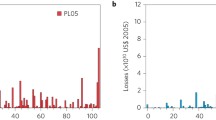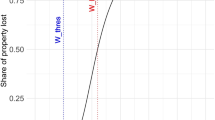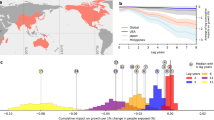Abstract
Tropical cyclones that make landfall on the coast of the USA are causing increasing economic losses. It is assumed that the increase in losses is largely due to socio-economic developments, i.e. growing wealth and greater settlement of exposed areas. However, it is also thought that the rise in losses is caused by increasing frequency of severe cyclones resulting from climate change, whether due to natural variability or as a result of human activity. The object of this paper is to investigate how sensitive the losses are to socio-economic changes and climate changes and how these factors have evolved over the last 50 years. We will then draw conclusions about the part the factors concerned play in the observed increase in losses. For analysis purposes, storm loss is depicted as a function of the value of material assets affected by the storm (the capital stock) and storm intensity. The findings show the increase in losses due to socio-economic changes to have been approximately three times greater than that due to climate-induced changes.




Similar content being viewed by others
Notes
The term “tropical cyclone” is used to designate storms with wind speeds of more than 63 km/h that form over the sea in the Tropics. Depending on the region, they may be referred to as typhoons in the northwest Pacific, cyclones in the Indian Ocean and Australia, and hurricanes in the Atlantic and northeast Pacific.
This short-term trend for the period 1971–2005 is confirmed by applying the dataset in Pielke et al. (2008).
Sachs also analyses US tropical cyclone losses. However, the paper does not clearly indicate on what loss data it was based and from what source they were taken.
There are indications that the intensity of tropical cyclones is affected by climate change. The destructive force of tropical cyclones has been increasing globally since the mid-1970s. This correlates very closely with the sea surface temperature (SST) (cf. IPCC 2007a; Emanuel 2005; Webster et al. 2005). According to Barnett et al. (2005) there is also a correlation between SST and anthropogenic greenhouse gas emissions. The SST is not the only factor that influences intensity, however. It is possible that other factors are even more important, e.g. wind shear (cf. Knutson and Tuleya 2004; Bengtsson et al. 2007; Emanuel et al. 2008). Climate change has an impact on various parameters like ocean temperature, atmosphere, circulation, and water vapour, and hence influences tropical storms. The processes involved are complex and not yet completely understood (cf. Wang and Lee 2008).
A detailed explanation of the variables and parameters can be found in Table 1.
A natural catastrophe is considered “great” if fatalities are in the thousands, numbers of homeless in the hundreds of thousands or material losses on an exceptional scale given the economic circumstances of the economy concerned (cf. Munich Re Company 2007, p. 46).
The NFIP provides data about insured losses due to flood. For the purpose of considering flooding losses in the estimated overall losses, we first subtracted the insured losses according to NFIP from the insured losses in NatCatSERVICE®. Then we reduced the estimated overall losses by the same proportion.
The breakdown was carried out by determining the region affected by each landfall. The proportion of overall losses for each region affected was based on the aggregate and regional losses reported by the Property Claims Service (cf. PCS, https://www4.iso.com/pcs, download 14.03.2007). The overall loss figures from NatCatSERVICE® were split in the same proportions. NatCatSERVICE® itself only has aggregate storm loss details. We were not able to apportion the figures for some storms, for instance if storms that made landfall twice in the same state or if the loss was below the threshold at which storms are recorded in PCS catastrophe history.
Regression analysis details are shown in Table 1.
1 kt = 1.852 km/h.
Thanks to an anonymous reviewer for the recommendation to use the square root of ACE instead of ACE.
Sea surface temperatures in the North Atlantic fluctuate due to the Atlantic Multidecadal Oscillation (AMO), referred to either as a “cold phase” or a “warm phase”, depending on the deviation from the long-term average. Warmer phases cause greater tropical storm activity (cf. Emanuel 2005; Webster et al. 2005). The terms “cold phase” and “warm phase” are contested among tropical cyclone experts (cf. Goldenberg et al. 2001; Zhang and Delworth 2006; Kossin and Vimont 2007; Mann and Emanuel 2006). Among those positing an AMO influence the beginning of the last “cold phase” is under discussion. We refer to Goldenberg et al. 2001 taking 1971 as the beginning.
Allocation of phases according to Goldenberg et al. (2001).
Nordhaus bases this on the following: wind speed is not the only factor involved; possible statistical errors in measuring wind speed, correlation of wind speed and omitted variables and the different extent to which the losses depend on building structure (cf. Nordhaus 2006).
Nordhaus’ dataset for the period 1851–2005 comprises 281 storms, but includes 139 storms without any information on damage.
Table 3 shows the regression results in detail.
Details of the regression analysis are shown in Table 4. In our data, we divided storms that made landfall more than once into separate storm events. As Nordhaus does not make this distinction, for comparison purposes, we have not divided the storms into separate events, when we apply the Nordhaus method to our data.
If Hurricane Katrina is excluded, because there is a large difference in estimated loss between the datasets (81 bn US$ and 125 bn US$), the mean estimated loss is 3,096.0 million US$ and 3,264.4 million US$, respectively. Mean wind speed is 173.0 km/h, respectively, 168.5 km/h. Loss elasticity to wind speed change is 5.9 (data from Nordhaus’ dataset) and 4.8 (data from NatCatSERVICE®). Table 5 show the regression results in detail.
Sea surface temperatures in the North Atlantic fluctuate due to the Atlantic Multidecadal Oscillation (AMO), referred to either as a “cold phase” or a “warm phase”, depending on the deviation from the long-term average. Warmer phases cause greater tropical storm activity (cf. Emanuel 2005; Webster et al. 2005). The terms “cold phase” and “warm phase” are contested among tropical cyclone experts (cf. Goldenberg et al. 2001; Zhang and Delworth 2006; Kossin and Vimont 2007; Mann and Emanuel 2006). Among those positing an AMO influence the beginning of the last “cold phase” is under discussion. We refer to Goldenberg et al. 2001 taking 1971 as the beginning.
Were one to look at the Pielke et al. (2008) dataset over the same period, the quantitative findings would be identical.
References
Barnett TP, Pierce DW, AchutaRao KM, Gleckler PJ, Santer BD, Gregory JM, Washington WM (2005) Penetration of human-induced warming into the world’s oceans. Science 309:284–287. doi:10.1126/science.1112418
Bengtsson L, Hodges KI, Esch M, Keenlyside N, Kornblueh L, Luo J-J, Yamagata T (2007) How may tropical cyclones change in a warmer climate? Tellus 59A:539–561. doi:10.1111/j.1600-0870.2007.00251.x
Bouwer LM, Crompton RP, Faust E, Höppe P, Pielke RA Jr (2007) Confronting disaster losses. Science 318:753. doi:10.1126/science.1149628
Bureau of the Census (1993) 1990 Census of population and housing: population and housing unit Counts United States, Washington, DC
Downton MW, Pielke RA Jr (2005) How accurate are disaster loss data? The case of U.S. Flood Damage. Nat Hazards 35:211–228. doi:10.1007/s11069-004-4808-4
Emanuel K (2005) Increasing destructiveness of tropical cyclones over the past 30 years. Nature 436(August):686–688. doi:10.1038/nature03906
Emanuel K, Sundararajan R, Williams J (2008) Hurricanes and global warming: results from downscaling IPCC AR4 simulations. Bull Am Meteorol Soc 89(March):347–367. doi:10.1175/BAMS-89-3-347
Faust E (2006) Verändertes Hurrikanrisiko, Munich Reinsurance Company, Munich, http://www.munichre.com, download 2.2.2006
Faust E, Höppe P, Wirtz A, Schmidt S (2006) Trends in natural catastrophes—potential role of climate change. In: Höppe P, Pielke RA Jr (eds) Workshop on climate change and disaster losses: understanding and attributing trends and projections. report of workshop at Hohenkammer, Germany, 25–26 May 2006. University of Colorado, Munich Reinsurance Company, Boulder, Munich, pp 89–102
Goldenberg SB, Landsea CW, Mestas-Nuñes AM, Gray WM (2001) The recent increase in Atlantic hurricane activity: causes and implications. Science 293:474–479
Hallegatte S (2008) An adaptive regional input-output model and its application to the assessment of the economic cost of Katrina. Risk Anal 28(3):779–799. doi:10.1111/j.1539-6924.2008.01046.x
Höppe P, Pielke RA Jr (eds) (2006) Workshop on climate change and disaster losses: Understanding and attributing trends and projections, report of workshop at Hohenkammer, Germany, 25–26 May 2006. University of Colorado, Boulder and Munich Reinsurance Company, Munich, http://sciencepolicy.colorado.edu/sparc/research/projects/extreme_events/munich_workshop/index.html. download 11.1.2007
Howard RA, Matheson JE, North DW (1972) The decision to seed hurricanes. Science 176:1191–1202. doi:10.1126/science.176.4040.1191
Intergovernmental Panel on Climate Change (2007a) Climate change 2007: the physical science Basis, Contribution of Working Group I to the Fourth Assessment Report of the Intergovernmental Panel on Climate Change. Cambridge University Press, Cambridge
Intergovernmental Panel on Climate Change (2007b) Climate change 2007: impacts, adaptation and vulnerability, Contribution of Working Group II to the Fourth Assessment Report of the Intergovernmental Panel on Climate Change. Cambridge University Press, Cambridge
Kemfert C (2007) The economics of climate change. Int Polit 62(February):38–45
Kossin JP, Vimont DJ (2007) A more general framework for understanding Atlantic hurricane variability and trends. Bull Am Meteorol Soc (accepted)
Knutson TR, Tuleya RE (2004) Impact of CO2-induced warming on simulated hurricane intensity and precipitation: sensitivity to the choice of climate model and convective parameterization. J Clim 17(18):3477–3495. doi:10.1175/1520-0442(2004)017<3477:IOCWOS>2.0.CO;2
Mann ME, Emanuel K (2006) Atlantic hurricane trends linked to climate change. EOS 87(24):233–241. doi:10.1029/2006EO240001
Munich Reinsurance Company (2001) Topics: annual review of natural catastrophes 2000, Munich
Munich Reinsurance Company (2006) Topics geo: annual review. Natural catastrophes 2005, Munich
Munich Reinsurance Company (2007) Topics geo: natural catastrophes 2006. Analyses, assessments, positions, Munich
Nordhaus WD (2006) The economics of hurricanes in the United States, http://www.econ.yale.edu/~nordhaus/homepage/recent_stuff.html. download 2.3.2007
Pielke RA Jr (2007) Future economic damage from tropical cyclones: sensitivities to societal and climate changes. Philos Trans R Soc. doi:10.1098/rsta.2007.2086
Pielke RA Jr, Crompton R, Faust E, Gratz J, Lonfat M, Ye Q, Raghavan S (2006) Factors contributing to human and economic losses. Paper presented at the International Workshop on Tropical Cyclones VI, San Jose, Costa Rica, USA, Nov–Dec 2006, http://severe.worldweather.org/iwtc/document.htm. download 5.1.2007
Pielke RA Jr, Gratz J, Landsea CW, Collins D, Saunders M, Musulin R (2008) Normalized hurricane damages in the United States: 1900–2005. Nat Hazards Rev 9:29–42. doi:10.1061/(ASCE)1527-6988(2008)9:1(29)
Pielke RA Jr, Landsea CW (1998) Normalized hurricane damages in the United States 1925–95. Weather Forecast 13(09):621–631. doi:10.1175/1520-0434(1998)013<0621:NHDITU>2.0.CO;2
Sachs A (2007) Using spatial analysis to establish a relationship between hurricane attributes and damages, http://www.gsd.harvard.edu/academic/fellowships/prizes/gisprize/ay06-07/sachs.pdf. download 29.12.2007
Schmidt S, Kemfert C, Höppe P (2008) Tropical cyclone losses in the USA and the impact of climate change: a trend analysis based on a new dataset. DIW Discussion Paper 802
Wang C, Lee S-K (2008) Global warming and United States landfalling hurricanes. Geophys Res Lett 35:L02708. doi:10.1029/2007GL032396
Webster PJ, Holland GJ, Curry JA, Chang H-R (2005) Changes in tropical cyclone number, duration, and intensity in a warming environment. Science 309:1844–1846. doi:10.1126/science.1116448
Zhang R, Delworth TL (2006) Impact of Atlantic multidecadal oscillations on India/Sahel rainfall and Atlantic hurricanes. Geophys Res Lett 33:L17712. doi:10.1029/2006GL026267
Author information
Authors and Affiliations
Corresponding author
Rights and permissions
About this article
Cite this article
Schmidt, S., Kemfert, C. & Höppe, P. The impact of socio-economics and climate change on tropical cyclone losses in the USA. Reg Environ Change 10, 13–26 (2010). https://doi.org/10.1007/s10113-008-0082-4
Received:
Accepted:
Published:
Issue Date:
DOI: https://doi.org/10.1007/s10113-008-0082-4




